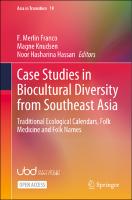Case Studies in Biocultural Diversity from Southeast Asia
Traditional Ecological Calendars, Folk Medicine and Folk Names
Contributor(s)
Franco, F. Merlin (editor)
Knudsen, Magne (editor)
Hassan, Noor Hasharina (editor)
Language
EnglishAbstract
This open access book demonstrates the linkages between local languages, traditional knowledge, and biodiversity at the landscape level in Asia, providing a fresh approach to discussions on Asia’s biocultural diversity. The book carries forward earlier analyses but importantly focuses on ‘traditional ecological calendars,’ ‘folk medicine,’ and ‘folk names’ in the context of the vital importance of maintaining biological, cultural, and linguistic diversity. It does this by addressing a range of cases and issues in relation to Southeast Asia: Brunei Darussalam, Indonesia, Malaysia, the Philippines, and North-East India. The several chapters demonstrate the ways in which the various forms of knowledge of the environment and its categorizations are important in areas such as landscape and resource management and conservation. They also demonstrate that environmental knowledge and the practical skills which accompany it are not necessarily widely shared. This book sends important messages to those who care about the sustainability of our environment, the maintenance of its biocultural diversity, or at least the maintenance of what remains of it because much has changed. This interdisciplinary collection draws from a wide range of disciplines and is of appeal to students and scholars in anthropology, environmental studies, geography, biodiversity, and linguistics. ; This book demonstrates the linkages between local languages, traditional knowledge, and biodiversity at the landscape level in Asia, providing a fresh approach to discussions on Asia’s biocultural diversity. The volume carries forward earlier analyses but importantly focuses on ‘traditional ecological calendars’, ‘folk medicine’ and ‘folk names’ in the context of the vital importance of maintaining biological, cultural and linguistic diversity. It does this by addressing a range of cases and issues in relation to Southeast Asia: Brunei Darussalam, Indonesia, Malaysia, the Philippines, and the culturally connected area of North-East India. The several chapters demonstrate the ways in which the various forms of knowledge of the environment and its categorisations are important in such areas as landscape and resource management and conservation. They also demonstrate that environmental knowledge and the practical skills which accompany it are not necessarily widely shared. This book sends important messages to those who care about the sustainability of our environment, the maintenance of its biocultural diversity, or at least the maintenance of what remains of it because much has changed, and the impacts of culture-carrying human beings on nature. This interdisciplinary collection draws from a wide range of disciplines, and is of appeal to students and scholars in anthropology, geography, biodiversity and linguistics.
Keywords
Folk Medicine; Folk Names; Indigenous Languages; Traditional Knowledge; Traditional Ecological Calendars; Biocultural Diversity from Southeast AsiaDOI
10.1007/978-981-16-6719-0ISBN
9789811667190, 9789811667190Publisher
Springer NaturePublisher website
https://www.springernature.com/gp/products/booksPublication date and place
Singapore, 2022Imprint
Springer Nature SingaporeSeries
Asia in Transition, 19Classification
Biodiversity
Anthropology
Human geography
Language: reference and general
Physical geography and topography


 Download
Download Web Shop
Web Shop